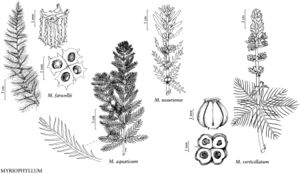Myriophyllum ussuriense
Bull. Acad. Imp. Sci. Saint-Pétersbourg 19: 182. 1873.
Herbs usually dioecious, rarelymonoecious, aquatic or semiaquatic, usually not forming dense stands. Stems often branched, to 0.6 m. Turions present, ± brown, narrowly cylindrical, with gradual transition from foliage leaves to highly reduced turion leaves, (4–) 7–12 (–20) × 0.5–2 (–3) mm, apex rounded to truncate; leaves often pectinate proximally and entire to 3-fid distally, strongly appressed to axis, lanceolate to narrowly elliptic or ovate in outline, (1.5–) 2–4 (–6.5) × (0.2–) 0.3–2 (–2.5) mm; segments 0–6 (–10), longest segment 0.5–2 mm, basal segment less than or equal to 1/2 central axisof leaf, apex ± acute or rounded, brown, long-necked, ascidiate trichomes in axils present. Leaves opposite or in whorls of 3 (or 4), heteromorphic; petiole 0–9 mm; submersed leaves usually pectinate, sometimes 2-lobed or 3-lobed, ovate to widely ovate or trullate in outline, (1.3–) 5–22 (–26) × (0.3–) 3–28 (–35) mm, segments (0–) 4–12 (–14), distinctly alternate, lobed to linear-filiform, longest segment (0.5–) 2–20 (–25) mm; emersed leaves usually linear, spatulate, or 2-lobed or 3-lobed, sometimes pectinate proximally, (1.7–) 2.5–9 (–10.5) × 0.3–3.5 (–5) mm, segments (0–) 2–8 (–12), lobed to linear-filiform. Inflorescences to 12 cm; flowers usually unisexual, rarely bisexual; bracteoles cream to stramineous, lanceolate, elliptic, ovate, or obovate, (0.2–) 0.3–0.7 (–0.9) × (0.1–) 0.2–0.4 (–0.5) mm, margins entire, irregular, dentate, glandular, or lobed. Staminate flowers: sepals cream, elliptic to lanceolate, 0.5–0.7 × 0.2–0.5 mm; petals persistent, cream, sometimes apically suffused with purple, widely oblanceolate, 1.2–2.5 × 0.7–1.2 mm; stamens 8, filaments to 1.4 mm, anthers 0.9–1.8 × 0.2–0.4 mm. Pistillate flowers: sepals and petals rudimentary or absent; pistils to 0.7 mm, stigmas white, to 0.3 mm. Fruits subglobose, 4-lobed. Mericarps brown, obovate, 0.8 × 0.6 mm, abaxial surface rounded, minutely tuberculate, wings and ribs absent. 2n = [14] 21.
Phenology: Flowering and fruiting Jul–Nov.
Habitat: Streams, rivers, muddy shorelines of ponds and lakes, intertidal wetlands.
Elevation: 0–600 m.
Distribution
B.C., Oreg., Wash., Eurasia
Discussion
Plants of Myriophyllum ussuriense typically grow in a semi-terrestrial habit in shallow water or on saturated sediments to a height of 20 cm. Shoots often have swollen stem bases that taper dramatically towards the apex. In some populations, extensive production of erect shoots from rhizomes produce dense stands. The floral bracts are distinctive, being opposite or alternate and elongate with usually 2–8 relatively short segments. Dimorphism in size between staminate and pistillate flowers of M. ussuriense is distinctive. Although most populations appear to be unisexual with staminate plants predominating and pistillate plants rare (O. Ceska et al. 1986), the latter are extremely small with a vestigial perianth and are easily overlooked, indicating that monoecy may be more common than thought in this species. S. Ueno and Y. Kadono (2001) reported that seven of 80 populations of M. ussuriense in Japan had some monoecious plants. No fruit was found despite an extensive examination of available material.
Submersed plants have pectinate leaves that are extremely delicate with usually fewer than 12 straight segments. A useful characteristic of some leaves is that the central axis terminates in a right-angled bifurcation.
Selected References
None.
